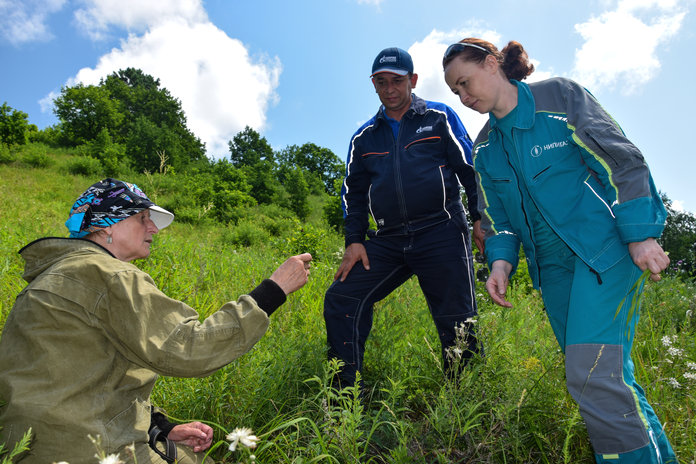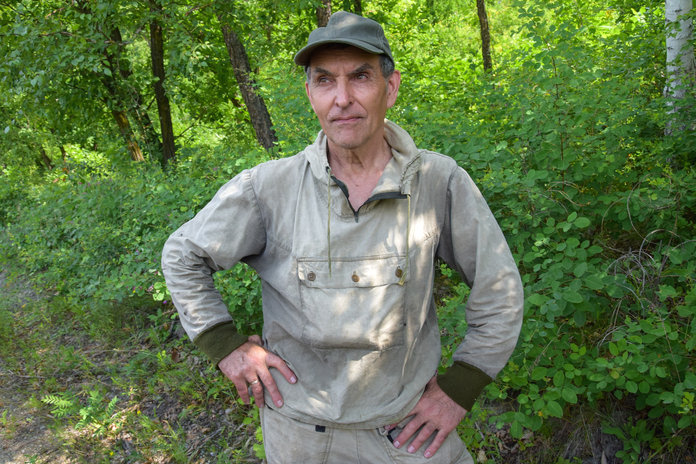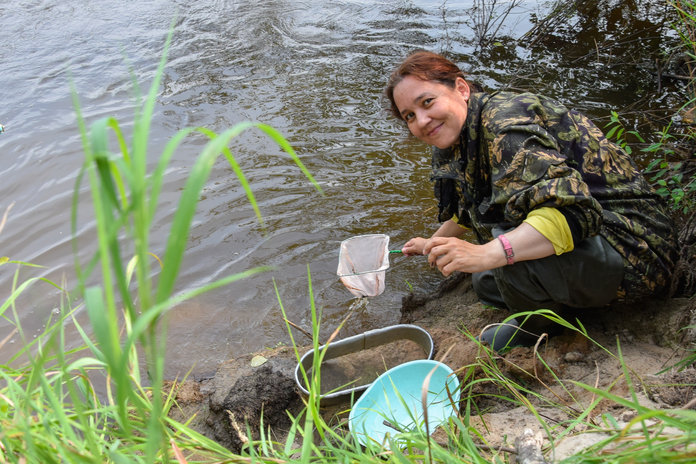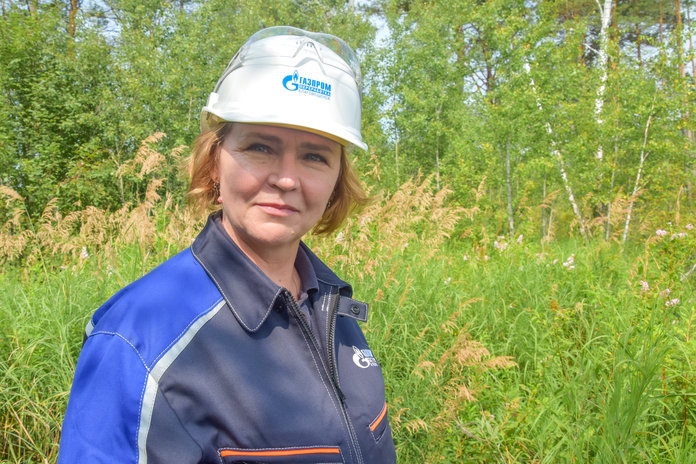How does the beautiful Bolshaya Pyora River get on next to the large-scale construction site of Amur GPP?
Construction of the Amur Gas Processing Plant is a large-scale project that is significant for our town, region and the entire Far East. But today, we will talk not about the progress of its construction and not about the capacity, which has already been discussed a lot, but about the impact of the new plant on the environment.
The topic is very sensitive, given how zealous many local residents are about environmental issues and often express their concerns both at meetings of the Public Council of the Amur GPP/Amur GCC and in their letters to our newspaper.
To clarify the situation, we have decided to collect research facts: scientists of the Institute of Water and Environmental Problems of the Far Eastern Branch of the Russian Academy of Sciences have assessed the natural environment in the construction area of the Amur GPP for multiple years. In early August, a group of experts from this institute conducted a large study of the Bolshaya Pyora River basin. We talked with the expedition members who have science degrees of candidates of biological sciences, as well as with the environmental professionals of the Amur GPP itself.
— Why is it necessary to conduct environmental studies? And what is the subject of your studies?
— Biological diversity. Lyubov Antonova, a lead researcher at the Vegetation Ecology Laboratory of the Institute of Water and Environmental Problems of the Far Eastern Branch of the Russian Academy of Sciences, explains: «It plays a crucial role in the structural and functional organization of ecosystems. Animals and plants are of great practical importance for humans. Biodiversity is very sensitive to environmental disturbances: it objectively reflects changes in the ecological situation of the territory as a result of anthropogenic impact. The state of the animal and plant world is the most important indicator of the level of anthropogenic impact on the natural environment.

Lyubov Antonova (to the left).
Regular surveys enable tracking the density of populations of the flag species, and this is one of the most important indicators of the state of the ecosystem. In the south of the Far East where flora and fauna are very rich and have unique features, understanding their condition and assessing the impact on them during construction are of great research and practical importance. In this regard, monitoring studies are necessary in the construction sites that have an impact on biodiversity.
According to IFC Performance Standard 6, the protection and conservation of biological diversity and sustainable management of living natural resources are fundamental to sustainable development.
— What are the features of the natural environment in the construction area of the Amur GPP, and what is it remarkable for?
— The area of the Amur Gas Processing Plant under construction is located in the southern part of the Amur region, on the Amur-Zeya plain (Amur-Zeya plateau) in the area of contact of various types of flora and fauna. Representatives of the Amur (Manchurian) flora and fauna predominate in the local biocenoses, and representatives of the Dauriya-Mongolian, East Siberian, Okhotsk-Kamchatka flora and fauna are found. This determines the high level of biodiversity of the territory and its specifics. As a result of the long-term development of this part of the Amur region, the landscapes and biodiversity of the Amur GPP area have undergone significant changes.
The areas of forest biocenoses have greatly decreased, their significant degradation has occurred; extensive woodlands, farmland, including fallow lands have been formed under the impact of fires, deforestation, land reclamation, plowing, and other factors. There are settlements, roads, and railways, quarries, power lines, etc., in the area of construction of the Amur GPP and in adjacent territories.
Construction of Amur GPP facilities does not have the features of early development of the territory. Biodiversity in the area has mostly preserved its main parameters and properties. Regular monitoring during construction of such a large facility as the Amur GPP is of great practical and fundamental importance for assessing the state of the environment as a whole in the south of the Amur region and forecasting potential impacts.
Rare plant species listed in the Red List of Russia are quite common in the immediate vicinity of the gas processing plant under construction. This includes: Japanese iris, Pumilum lily and Busch lily, Baikal skullcap, Chinese bellflower, Turchaninov pasqueflower. The research is conducted for the fourth year, but not a long time has passed, so it is too early to draw any conclusions. Nevertheless, according to our observations, there are no changes in the state of plant communities. Native species feel quite comfortable."

Aleksandr Antonov.
— What else is paid attention to when conducting research?
Aleksandr Antonov, another member of the research team, zoologist, lead researcher at the Animal Ecology Laboratory of the Institute of Water and Environmental Problems of the Far Eastern Branch of the Russian Academy of Sciences, explains: «Scientists are closely watching the wildlife in the plant construction area. Roe deer, wild boars, foxes, badgers, muskrats, raccoon dogs, hamsters, and birds are in the area of our observations. Zoologists not only track land animals, but also look for any traces of their vital activities: tracks, burrows, etc. Based on our observations, there are generally no significant changes in the population and fauna of vertebrates, including fish. A set of materials will be compiled based on the study results to continue monitoring the biodiversity in the future, as well as to assess the existing and projected impacts of the new plant on nature.
— And what have the studies of the Bolshaya Pyora River itself show?
«Bolshaya Pyora River flows from the right bank into the Pyorskaya bayou (Zeya River) two kilometers away from the mouth. The river is 145 km long. Its catchment area is 4400 square km. The river has 31 tributaries with a length of less than 10 km and the total length of 83 km. There are 218 lakes in the catchment area with a total area of 3.30 square km. The greatest density of the river network is 0.24 km/square km, while the rate of waterlogging of the catchment area is 14%. Water is low-mineralized (up to 1,000 mg/l), with a predominance of HCO3 as anions.In terms of the water regime, the river belongs to the Far Eastern type with a well-pronounced predominance of a rain flow. The monsoon nature of the climate determines the main features of its regime. Floods are observed mainly in July and August. The bottom is represented by sand, silted in some places with a small amount of detritus. Water temperature during the sampling period was 21°C. The state of this vast water world is monitored by a hydrobiologist. Observations of invertebrates in the river watercourses make it possible to assess the state of the river ecosystem.

Nadezhda Yavorskaya.
Nadezhda Yavorskaya, candidate of biological sciences and hydrobiologist, sampled the zoobenthos (organisms living in the soil of water reservoirs) and fishing of specimens (imagos) of aquatic insects at three control points in the lower reaches of the Bolshaya Pyora River. Measurements of the water temperature, its transparency, odor, and general assessment of the condition of the water reservoir were also carried out. Seven to ten quantitative benthos samples were taken at each point. Then their density, biomass, and species composition were later determined in the laboratory.
— Larvae of mayflies, stoneflies, caddis flies, and bivalve mollusks are good biological indicators of the purity of fresh water since they like flowing oxygenated water. When water streams become polluted, stoneflies, mayflies, as well as many species of buzzers are the first to disappear. These aquatic insects are doing great right now in the Bolshaya Pyora River. We do not observe any negative changes either in the turbidity of the water or in the temperature regime. In general, this river has a rich species composition, and some endemics and rare species of hydrobionts have been found."
— And what can be said to the statements of some Svobodny residents that the Pyora River has become more muddy and dirty?
Nadezhda Yavorskaya says: «One can hardly agree with this. I had to work on many reservoirs, including in remote water reserves. So I can compare. I had to see mountains of garbage in the deep taiga or an emergency dump of fuel oil from a military unit when an oil film is visible on the surface of the water from above. The smell there is unpleasant. Here in the Amur GPP area, we take samples upstream from the outlet of the sewage treatment units and then downstream; according to the results of the studies, there is no difference between the samples in terms of color, turbidity, or odor.
The water discharged from the treatment facilities meets the requirements for wastewater for fisheries reservoirs. Turbidity usually occurs during precipitation and floods, when all the garbage is washed away from the shores, and it can include remnants of picnics with food waste or remnants of spilled oils and fuels. The river cleans itself later and restores its fauna quite quickly.
Another thing is that the Bolshaya Pyora per se is not rich in fish. The river is shallow and fast, and fish prefers to be near vegetation along the banks or moves into tributaries and lakes to feed. The riverbed is sandy and clean; with such soil, just like with clay soils, there is usually not much biodiversity.
Nevertheless, your sandy river is quite lively. It is home to Amur endemics, bivalve mollusks characteristic only for your region, and very rare species of mayflies that lay eggs in the near-bank zone. Stoneflies are no less remarkable: this is the main indicator of clean water. If the conditions were unfavorable, the stoneflies would immediately disappear, followed by mayflies. However, we have not noticed any decrease in their population over the past three years. This means that the Bolshaya Pyora is quite comfortable for its inhabitants.
At the moment, there is no need to perform any extra offset measures in the construction area to restore animal habitats (including zoobenthos and ichthyofauna), as well as to develop any special measures for conservation of specially protected species. We all just need to be more attentive and careful about the environment, without throwing garbage on floodplains of water reservoirs."
— Please tell what environmental safety requirements are imposed on such large construction projects as a whole.
Vera Alushkina.
Vera Alushkina, Deputy Head of the Environmental Protection Department, explains: «Depending on the level of negative impact on the environment, there are four categories of impact: significant, moderate, insignificant, and minimal ones. Construction of capital facilities lasting more than six months is a criterion for classifying the Amur GPP project as facilities that have a minor negative impact on the environment, that is, category 3.
All people operating at the facilities of category 3 of negative impact on the environment shall perform a number of duties to monitor the activities of such facilities: implementation of industrial environmental monitoring (IEM) in accordance with the approved IEM program; laboratory tests at the boundary of the sanitary protection zone taking into account the characteristics of the processes and meteorological characteristics of the environment to the extent and with a frequency determined by IEM program; keeping records of waste generated, disposed of, neutralized, transferred to other entities or received from other entities; providing reports on the company and results of IEM implementation in accordance with the established procedure.

Rafael Musin.
— How long have such studies been conducted? What do they give?
Rafael Musin, Head of the Environmental Protection Department at Gazprom Pererabotka Blagoveshchensk LLC, explains: «Monitoring studies of biodiversity in the construction area were first conducted in July 2019 in accordance with IFC requirements. The activities of the scientists in August 2022 became the next stage of the comprehensive environmental monitoring of the project. Water, sediments, air, soil, as well as animal and plant life will also be regularly studied in future.
More than 2,000 different samples have been studied for now. No violations of the environmental requirements have been detected for the entire observation period. The activities of the scientists have confirmed the safety of construction and compliance of the main parameters with Russian and international environmental standards. A set of materials will be compiled for use in further operations based on the research done this year. When conducting new monitoring studies, we will look carefully at the data of the scientists and analyze the dynamics of the parameters."
Source: Zeyskie Ogni newspaper
